The Year 2024
With Chris and Sue Jackson
Just a vignette of our past year. Not one of our best I suppose, as I was taken into hospital twice with griping stomach pains, subjected to various scans, blood tests, gastroscopies, endoscopies and evil IV antibiotics. Nothing was concluded, the pains faded away and I was discharged. Sue was even more grumpy that me as we had to cancel a three week walking and travel holiday to the desert states of America.
However, we did manage to get away a few times in the campervan, here are some snapshots.
1-5
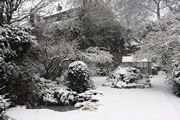
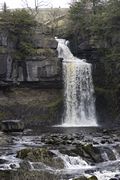
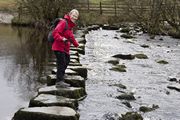
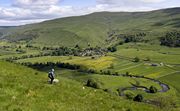
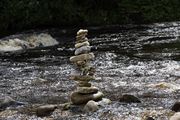
In February we had a heavy overenight dump of wet snow, 14 inches on our patio but in true English tradition, within two days most of it had melted away or turned to slush. Outrageous, it wouldn't have happened back 1963 when we were bivviing in caves and bus shelters. In April, despite dire warnings from the weather men we headed for the Yorkshire Dales and stayed at Thornbrook Barn campsite a couple of miles outside Ingleton. The Ingleton waterfall trail was running well, though I got into trouble when we got disorientated and we were unintentionally subjected to a line of slippery limestone stepping stones which we eventually had to reverse and which Sue hates.We also climbed Ingleborough in driving drizzle and thick cloud, and visited White Scar caves which at £18 each seemed poor value for a simple stream passage.
- It also snows here
- Ingleton waterfall walk.
- Lost in the Dales
- Starbotten, Wharfedale
- A prime specimen of the cairn builders art on the Wharfe near Hubberholme
6-10
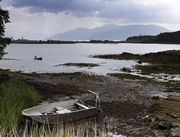
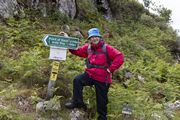
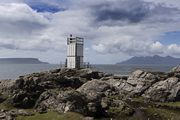
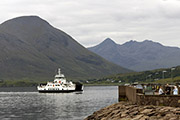
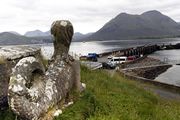
In May we headed to Scotland, Skye to be precise but to break the long drive we spent a few days based at Buckden in Wharfedale, very pleasant too.
After 4 days, we pressed on northwards after our Yorkshire Dales stop-off, and arrived many hours later at Broadford on Skye, where we stayed at the excellent community run site. We explored the lesser travelled Sleat peninsula which has a fine ruined house at Armadale and next day checked out Skye's most southerly point and lighthouse, or what passed for it at the Point of Sleat. While in Broadford we visited the local gin shop where we (I) bought the most expensive gin ever at £59, Bridge Gin. Fortunately Sue didn't like it so it lasted a bit longer.
Many years ago, while climbing mountains in the Coullin (were we even married?) we took an impromptu spur-of-the-moment trip to Raasay in our estate car. The weather was kind and we explored all the interesting bits of this long thin island. Sue is a sucker for nostalgia so we had to go for a re-enactment. Little had changed, there was a new distillery however with excellent Raasay gin, still no campsite and the weather this time was a bit 'mixed'.
The mermaids of Raasay played an unfortunate part in the history of the island, by contributing to the bankruptcy of the MacLeods of Raasay. During the 17th century the clan chief sent an artist to Italy to find two life-sized stone mermaids for the front of Raasay House. The artist spent years touring Europe at the chief's expense before coming back with two huge statues but the chief refused to pay the bill on the grounds that that he had asked for life-sized mermaids and that these were larger than life. Trouble ensued.
- 6. Looking along the Sleat peninsula
- 7. On route to the Point
- 8. The lighthouse at Point of Sleat
- 9. The ferry to the Isle of Raasay
- 10. The mermaids of Raasay
11-14
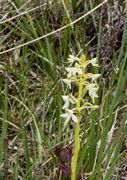
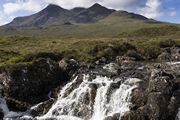
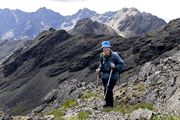
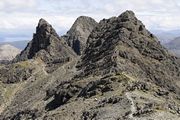
From Broadford, we moved on to the campsite at Sligachan. It's a bit basic but it had all the necessary bits like hook-ups and showers. It is also an excellent base for walking and is very close to the Sligachan hotel. Day one we pottered along the vague and slow going paths beside Loch Sligachan that would lead to the famous tombolo at Aird. Tombolo? A long spit of sand linking an island. We didn't quite make the there and back having lost the path twice but there were lots of flowers.
A weather widow opened and we decided to head into the hills. The easiest approach to the ridge is via Fionn Choire and up to Bruach na Frithe, slope of the deer so that is what we took though it is quite a long day out. At the ridge Sue went on strike but I pushed on up the last 300 feet of scrambling to the only summit in the Coullin with a trig point, Bruach na Frithe. On our return, as we neared the Sligachan hotel we decided to go for a meal and a couple of pints. Not to be, someone with money had closed the pub and reserved it for a wedding reception. Chilli con carne and Vino ruffino again then.
- 11. Lesser Butterfly orchid
- 12. Sgurr nan Gillean, and Am Basteir
- 13. On the ridge, Sue goes on strike
- 14. Am Basteir and Sgurr nan Gillean.
15-18


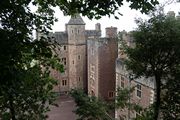
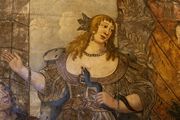
Back home for a while, we visited the ancient monument of Haddon Hall which, despite almost being on our doorstep we had never visited.
Haddon Hall, is the private residence of Lord and Lady Edward Manners, is set in the Peak District in the valley of the River Wye.
With nine hundred years of history, it is one of the oldest houses in the country and moreover one of the only houses in England to have remained in one family’s ownership for its entire existence. The Medieval Banqueting Hall remains furnished with its original Dais table, behind which hangs a tapestry gifted to the family by visiting Henry VIII. The Parlour boasts its glorious Tudor painted ceiling of Tudor roses and marvellous heraldic paneling. Exquisite and very rare 15th century fresco seccos adorn the walls of the Medieval Chapel.
We moved on, packed the campervan and headed for the Southwest. Cornwall is a long drive from Sheffield so we broke the journey by stopping at the CAM site in Minehead, which is Somerset. Next day we dropped in at the NT Dunster castle which, last time we were here was closed for renovation.
Dunster Castle is a forme motte and bailey castle, now a country house, in the village o fDunster, Somerset. The castle lies on the top of a steep hill called the Tor, and has been fortified since the late Anglo-Saxon period. After the Norman Conquest of England in the 11th century, William de Mohun constructed a timber castle on the site as part of the pacification of Somerset. A stone shell keep was built on the motte by the start of the 12th century, and the castle survived a siege during the early years of the Anarchy. At the end of the 14th century the de Mohuns sold the castle to the Luttrell family, who continued to occupy the property until the late 20th century.
- 15. Haddon Hall. I think that Judas has had one too many.
- 16. Enigmatic fireplace adornment in Haddon Hall. Is that a keyboard that she is clutching and what has it got to with her left tit?
- 17. Dunster castle
- 18. Cleopatra clutches an asp to her bosom at Dunster castle.
19-23
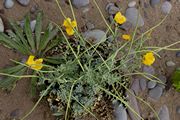
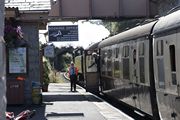
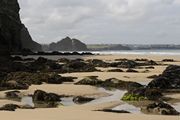
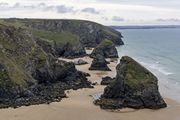

We walkled along the beach to the small town of Watchet and caught the steam train back to Minehead. The huge expanse of tidal flats NE of Minehead sported quite a few flowers that we were not familiar with.
From Minehead we headed into Cornwall and stayed in a farm campsie at Gwithian, a few miles up coast from Hayle and in easy bus-reach of St. Ives. Sue, being the art buff that she is wanted to visit Tate Modern in St. Ives. Some interesting stuff and quite a bit of pretentious rubbish.
- 19. Horned Poppy
- 20. Catching the train at Watchet.
- 21; Near Hayle
- 22. Bedruthan Steps.
- 23. In Tate Modern with Brazilian artist Beatriz Milhazes Maresias
Round, like a circle in a spiral like a wheel within a wheel
Never ending or beginning on an ever-spinning reel
Like a snowball down a mountain or a carnival balloon
Like a carousel that's burning running rings around the moon
Like a clock whose hands are sweeping past the minutes of its face
And the world is like an apple whirling silently in space
Like the circles that you find In the windmills of your mind.
24-27

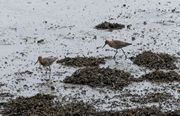
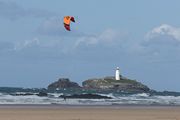
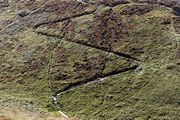
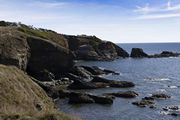
Our campsite at Gwithian was almost on the sea front, seperated by a barrier of sand dunes. Quiite attractive and in view of Godrevy island and it's lighthouse. Sue wanted to walk down the dunes to check out various nature reserves in the Hayle estuary. I'm not a big fan of sand dunes, they seem to get into my shoes but they do sport some unusual plant life. Not all was lost though, there was an excellent cafe near The Towans and in the Riviera reserve we spotted Greenshanks, Redshanks and Bar-Tailed Godwits.
Moving on we stayed at the excellent little Sea View campsite which was about a mile outsite Mullion and within an easy bus trip to The Lizard, Britains most southerly point.
- 24. Sue, in the cafe at The Towans
- 25. Bar-Tailed Godwits.
- 26. Godrevy island and windsurfer.
- 26. It's not all flat around here.
- 27. View of Lizard Point.
28-32
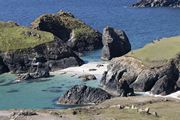
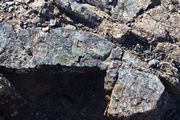
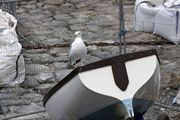
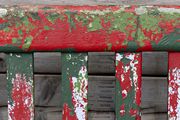
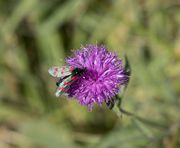
The path between Lizard Pointand Kynance Cove is well used, unsurprisingly as it's only a mile or so and sports some splendid coastal scenery. There's also outcrops of serpentine, a fairly rare blue-green rock made famous by Queen Victoria's mantlepiece.
In 1846, Queen Victoria and Prince Albert called at Penzance aboard the royal yacht. Ashore, they were shown specimens of polished serpentine. Enchanted by the colours, the royal holidaymakers made an unscheduled visit to see the rock in its natural surroundings. They ordered many serpentine items for their Osborne House residence, including several mantelpieces and twelve polished vase bases. News of the stone travelled among the great-and-good of the land; with royal approval, serpentine grew as a fashionable material.
- 28. Kynance Cove. The tide too far in to visit Asparagus Island without swimming.
- 29. Serpentine
- 30. Cadgwith Cove
- 31. Art for arts sake, Cadgwith Cove.
- 32. Six-spot Burnet moth on Knapweed.
33-37
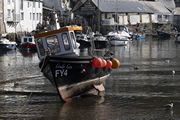
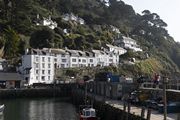
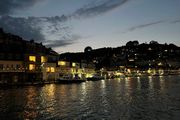
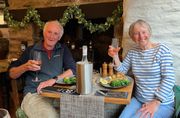
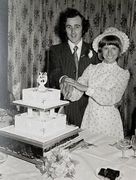
September 21st marked our Golden Wedding anniversary. We found ourselves based in a CAM site just outside Looe and where we found a semi-posh little restaurant called coincidentally 50. Prior to that we took the bus to Polperro and made the pleasant 5 mile walk back to Looe.
I offered to buy her an anniversay golden tiara but she didn't seem interested.
- 33. Polperro harbour, tide going out
- 34. Polperro from the harbour wall.
- 35. West Looe with evening lights
- 36. In the 50 restaurant where we were treated to £20 discount and some free booze.
- 37. Back in 1974. Sorry about the hair. Sue looking like Rita Tushingham, me looking like Ken Dodd.
Time to head home and a week of perfect weather was coming to an end. We chose to break the journey home at Burnham-on-sea, near Weston Super-mare. However, the next day meteorlogical hell broke loose, motorways were flooded and the country was subsumed by chaos. we chose to hunker down for an extra day in a gradually flooding campsite.
38-41
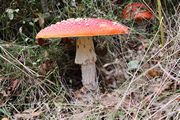
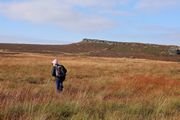
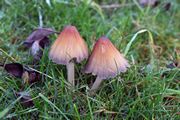
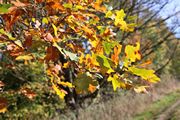
October, and we're back home, and the place hasn't burnt to the ground or been ravaged by voleurs. Autumn colours and a sprinkling of fungi in the fields and wood.
- 38. Fly Agaric fungus
- 39. Sue searches in vain for the Bog Rosemary
- 40. Ink Caps
- 41. Autumn Oak
